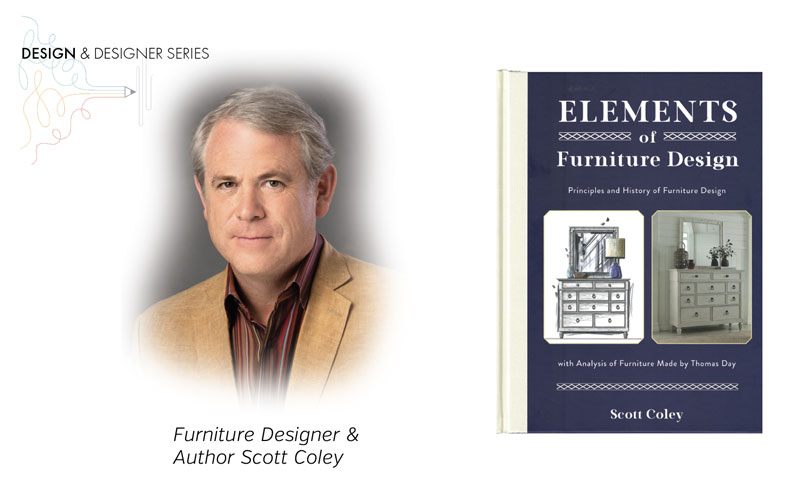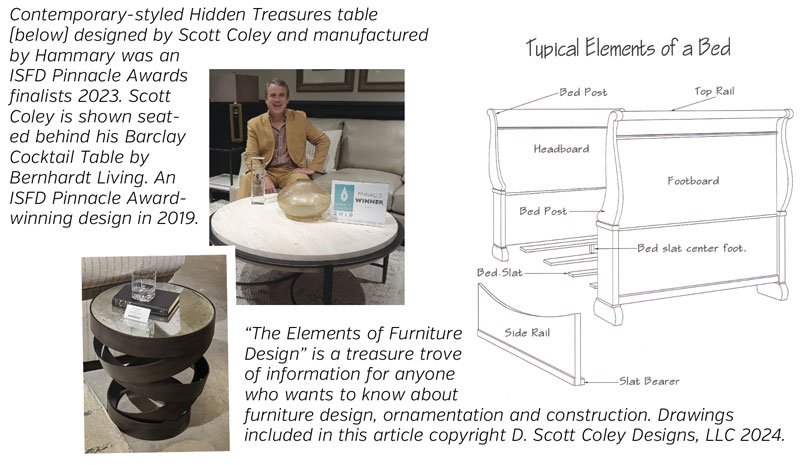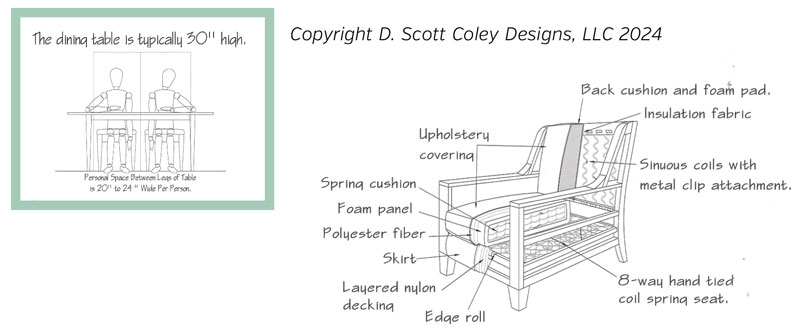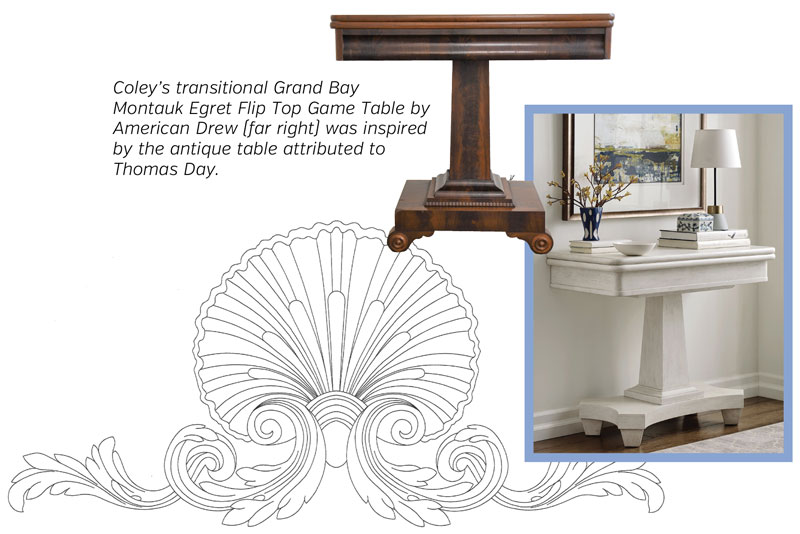INTERVIEW WITH FURNITURE DESIGNER AND AUTHOR SCOTT COLEY
Scott Coley unravels the past and present of furniture design and discusses
his plan to pass this knowledge along the supply chain via manufacturers and
retailers to consumers.
Scott Coley, author of the recently published book “Elements of Furniture
Design,” is a Pinnacle Award-winning furniture designer who learned his
craft at Kendall College of Art and Design.
Coley found his way into the furniture business naturally. His grandmother,
Ida Lee Rowe Coley, attended the New York School of Interior Design, founded
a furniture store in Newton, North Carolina, and designed interiors for
market showrooms and private homes. His great-grandfather, Charles Rowe,
owned New Town Mills, a textile mill, and a furniture factory that was
ultimately sold to Broyhill Furniture. Charles Coley, his father, graduated
from the furniture program at NC State University and founded a plastics and
upholstery operation.
Furniture World asked Coley to share how he started in the furniture
industry and why he decided to write “Elements of Furniture Design.”
“My dad,” Coley recalled, “recognized in me some qualities he had observed
in successful furniture designers, so he suggested I attend Kendall College
of Art and Design. During college, I worked at several of Bernhardt’s
factories and Hickorycraft Upholstery, where I gained first-hand production
knowledge. Early in my career, I was fortunate to meet many influential
freelance designers, including Jim Peed, Marty Pratt, Steve Hodges, Scott
Gregory and John Roser, as well as professionals working at design firms
such as Mitchell Prevost Designs and Berry and Clark Design Associates. With
my friend and fellow Kendall alumnus Tommy McDaniel, I founded McDaniel &
Coley, Inc., a freelance furniture design firm in Morganton, North Carolina.
We had a great run together before I established my firm, D. Scott Coley
Designs, LLC, in 2015.
“Along the way, I spent much time at the Bienenstock Furniture Library in
High Point and created an extensive personal library for research and
inspiration. In the summer of 2018, I started working on my book, published
earlier this year, anticipating that it would be a valuable reference tool
for furniture designers, manufacturers and retailers, as well as for people
with a more general interest in furniture and its design.”
An Evolving Profession
“In recent decades, product design in the home furnishings field has evolved
to include people who don’t always have formal furniture design training.
Sometimes, they know little about how furniture is made or the history
behind the styles they inspire. The book will also be useful for these
people: industrial designers, architects, furniture design stylists,
interior designers, and individuals with media backgrounds who create or
influence some of today’s furniture collection designs.

“I wrote in ‘Elements of Furniture Design’ that furniture design is an
ancient art that combines beauty, style, function and manufacturability.
“Much can be gained by passing knowledge about furniture history and home
furnishings trends beyond furniture designers along the supply chain that
leads through manufacturers and retailers to consumers. One reason I wrote
‘Elements of Furniture Design’ is to make this information accessible.”
Next Gen Furniture Designers
“I am thrilled to see the passion the next generation of furniture designers
have and the potential they hold for our industry,” Coley added. “The future
of home furnishing is brimming with creativity. With educational
opportunities like the Bienenstock Furniture Designers Summit, student
furniture design competitions offered by the Bienenstock Furniture Library
and ISFD’s Pinnacle Awards, students have a wonderful opportunity to see the
industry and be recognized. Through computer-aided drawing, ideas can be
brought to life swiftly and shared instantly across the globe. The Internet
enables us to collaborate with our peers, manufacturers, and retailers. This
rapid exchange of ideas and information promises to spark creative thought
that surpasses what was possible in past generations.
“Kendall professor Bruce Mulder once told me, ‘There is nothing new under
the sun when it comes to furniture design,’ a statement that underscores the
fact that our species has always been on a journey to enhance its living
spaces with places to eat, socialize and sleep. That journey continues
today. Furniture designers, manufacturers and retailers aim to give
customers precisely what they want and do whatever activities they envision,
more easily, beautifully and efficiently.”
The Language of Furniture Design
“The language of furniture design has changed dramatically in recent
decades. Gone is much of the focus on reproducing historic designs,
including those of 18th-century cabinetmakers. Those influences, however,
are still present in the marketplace. They’ve been repackaged to reflect
consumer preferences, lifestyles, trends and sometimes fads. In many ways,
the industry has evolved to be more fast-paced and creative. In other ways,
many manufacturer’s lines and retailers’ floors look strikingly similar.”
Coley said, “I was taught as a young designer and still feel that historical
design is relevant. The founding of the United States was intertwined with
the style sensibilities of England, France, and Spain, which rested on
architectural principles going back over two thousand years.
“Gone is much of the focus on reproducing historic designs. They’ve been repackaged to reflect consumer
preferences,
lifestyles, trends and sometimes fads.”
“Today,” he explained, “many furniture design elements and attention to
classical proportions we see in retail showrooms are rooted in these
historic styles. Even though today’s furniture may exhibit historical
silhouettes in a contemporary way, they still have timeless appeal and
continued marketability.
“As I stress in ‘Elements of Furniture Design,’ a furniture designer must
have comprehensive knowledge of these styles. However, this knowledge is not
meant to confine but rather to inspire. My experience designing for the
American home furnishing market, a melting pot of cultures, tells me that
traditional design knowledge is a launchpad for wider design creativity and
inclusivity, not a barrier.”
Traditional, Transitional & Contemporary
“Most of the products I design are transitional. However, I occasionally
enjoy experimenting with contemporary design, which appeals to a more
targeted market.
“Classical furniture design elements apply directly to transitional design,
blending modern materials and techniques with traditional forms and
ornamentation to create a harmonious balance.
“Simplified forms with reduced applied decoration characterize contemporary
furniture. Projections and moldings are eliminated. Materials and directness
of purpose are emphasized. These forms are generally lower in height than
traditional designs. Construction methods are typically similar unless a new
material is introduced.”

The Designer’s Responsibility
“It’s the furniture designer’s responsibility to reinterpret style elements
in a way relevant to today’s market. A serpentine shelf may reference
classical or traditional shapes and designs cleanly and simply. Consumers
find that a more relaxed, less formal feel results when historical details,
such as a cabriole leg, are used in modern or stylized ways.
“Because traditional design forms have been around for so long, they are
part of our collective consciousness. People understand them and recognize
their beauty. Shapes can reference masculine or feminine styles, telling
subtle stories to shoppers browsing furniture showrooms.
“Furniture design,” Coley suggested, “is an evolutionary process. Current
styles are always versions of what came before, adjusted for scale,
lifestyle, formality, comfort, color and texture.”
“Resort and coastal designs and groups incorporating cottage elements remain popular.”
Lifestyle Trends
“Most furniture designers are committed to creating furniture that resonates
with lifestyle stories customers want to reflect in their homes. When I
design furniture, I hope manufacturers and retailers will understand and
relate style elements; for example, how a louvered bed with beach
cottage-inspired ornamentation helps create the feeling of a coastal
lifestyle. That feeling can be enhanced by manufacturers in their Market
showrooms and retailers who display the represented lifestyle in ways that
improve shoppers’ appreciation and feelings that they must own this
furniture.
“Transitional designs,” Coley added, “continue to define the marketplace.
Resort and coastal designs and groups incorporating cottage elements remain
popular.”
Trend Analysis
“Design details, ornamentation, scale, finish and construction quality help
distinguish furniture items on the retail floor. To hit a bestseller, a
designer’s work must be consistent with what consumers want to put in their
homes.
“As formal dining and living room sales have declined, quality finishes have come to define a new
formality in
consumers’ minds.”
“That’s why decision-makers up and down the furniture production and
retailing chain must know what’s trending. Fashion Snoops is a wonderful
resource for trend information. They produce detailed reports and offer free
seminars at High Point Market. Trend Watch and MC&Co are other excellent
resources for deep dives into what consumers will likely purchase. These
companies share style and trend information, which can be found in industry
publications like Furniture World and Market displays at the American Home
Furnishings Hall of Fame building. The High Point Market Authority does a
great job of ensuring that manufacturers, retailers and designers have
access to information regarding the breadth of styles retailers and interior
designers can see at Market.”
Stand Out Designs
“Beyond referencing trends and making their designs appealing and
comfortable, designers must focus on creating products that stand out on
retail floors among a sea of options,” Coley noted. “Correct proportions,
finishes, hardware choices, fabric patterns, textures and colors are
essential elements required to do this well.”
He commented on how ornamentation relates to today’s customers. “While some
classical ornamentation has gone out of fashion, people still like to
associate themselves with a style, comfortable symbolism, or brand.
Consumers can still appreciate the meaning that underpins style and
ornamentation. Retail sales associates and interior designers who understand
the historical and cultural significance of the designs they sell have an
opportunity to tell stories that allow consumers to appreciate the history
and ideas these ornaments represent.”

Coley also pointed out, “Quality finishes have become more important because
they can make furniture stand out, look more expensive and are of higher
quality. As formal dining and living room furniture sales have declined,
quality finishes have come to define a new formality in consumers’ minds.”
“While some classical ornamentation has gone out of fashion, people still like to associate themselves
with a style,
comfortable symbolism, or brand.”
The Design Process
Coley told Furniture World that his design work has been advanced by his
practice of posing a specific series of questions. “These questions,”
mentioned in “Elements of Furniture Design,” he said, “act as a reliable
guide, aiding me in navigating the intricacies of the design process.
“I believe retailers can benefit from asking similar questions, so I’ve
reframed them for Furniture World readers.”
Style: What furniture styles need to be represented on our
sales floors? How might they be merchandised and displayed to address
best-selling core designs and evolving trends?
Lifestyle: How might these collections address the
lifestyles our customers aspire to and the homes they live in? How should we
allocate floor space to reflect contemporary lifestyles, relaxed resort
lifestyles, comfortable farmhouse lifestyles, or refined formal lifestyles?
Activity: What activities do people who conform to these
lifestyle groups engage in, and which product features will likely meet
their needs and encourage them to buy?
Current Line: What styles and lifestyles are over-or
underrepresented on our showroom floor? What’s missing that will likely
encourage traffic, help close more sales and increase average tickets?
Inspiration: How might our buyers, merchandisers and visual
merchandisers look for inspiration, find products and create displays that
are unique, eye-catching, and tell compelling stories?
“Keeping abreast of trends in new home construction can also yield a treasure trove of information,
providing insight
into room sizes, layouts and amenities.”
Inspiration
“Design inspiration is one of my favorite topics. It can come from many
sources,” Coley observed, “but as I explained in ‘Elements of Furniture
Design,’ design trips are a freeing way to get out into the field, see what
others are doing, and generate new ideas.
“Getting out of an office to visit domestic and international furniture
shows, design centers, and a variety of retail store formats is beneficial
in all stages of the creative process, from creating a spark of imagination
to selling designs off the retail floor. But if that’s impractical, shows
like HGTV and periodicals like AD, House Beautiful, House & Garden, Veranda,
and Elle Decor showcase a variety of design styles and ideas, from
traditional to modern and from small DIY projects to large-scale
renovations.
“I find that keeping abreast of trends in new home construction can also
yield a treasure trove of information, providing insight into room sizes,
layouts and amenities.
“I visited builders’ model homes furnished by interior designers for many
years, but today, this information is available online. Major builders post
building plans and renderings that anyone can access to find out what’s
being built in various locations. This information has been helpful to me as
a furniture designer and can be valuable to retailers located in areas with
lots of new construction.”

Thomas Day
“Many industry leaders have given me opportunities and inspiration. Some
that stand out,” Coley said, “are Alex Bernhardt, Lewis Norman, Rountree and
William Collett from Bernhardt; Rob Spilman, Matt Johnson; and Jeb Bassett
of Bassett Furniture, Art and Susan Barber of Charleston Forge; Steve
Kincaid, Tim Annas, and the merchandise and design team at La-Z-Boy
Casegoods, and many furniture designers that I have known personally or from
their excellent design work. I have also been inspired by historic furniture
designers, makers, and architects, including Thomas Chippendale, Charles
Mackintosh, Julia Morgan, and Thomas Day.”
Day, whose work is prominently featured in “Elements of Furniture Design,”
will be inducted into the American Furniture Hall of Fame during the 2024
October High Point Market.
“Thomas Day,” continued Coley, “was one of the most important cabinet
makers, designers, and furniture manufacturers in the Southern United States
during the 19th century. His designs are used throughout my book to
illustrate furniture design concepts. Day understood classical portions and
furniture styles when the furniture industry was transitioning from
cabinetmaking to modern furniture manufacturing.
“What made his accomplishments more inspiring was that Day, a skilled free
black craftsman in the antebellum South, built a substantial furniture
business in North Carolina before the Civil War. His manufacturing and
marketing ideas were ahead of their time.” He accomplished so much, with
everything working against him, illustrating that it is possible to achieve
great things even when the odds stacked against you are daunting.
“His manufacturing and marketing ideas were ahead of their time. He
pioneered ways to maximize production efficiency, use technology and create
infrastructure that was used 50 years later by manufacturers like Basset,
Broyhill and Bernhardt.”
Advice for Retailers
When asked what manufacturers and retailers can do to “up their design
game,” Coley suggested, “manufacturers can benefit from passing on more
design information to retailers. I’ve worked with some who go to great
expense to decorate their market showrooms in the style of a particular
collection and provide as much information as possible, but this is more of
an exception than a rule. When done correctly, the items will indeed sell
themselves.
“The retailers I meet and occasionally design products for are
sophisticated, professional business people. They understand what products
are moving off their floors, trending up and down. However, from my
perspective as a furniture designer, retail merchandisers, marketers and
salespeople can benefit from knowing more about the design influences and
construction of the products they sell. Improving this knowledge base and
educating salespeople about how to present unique features, advantages and
styles can link the ideas of designers who imagine home furnishings
collections to the desires of consumers who need to find value in these
items.”
Other Resources
In addition to “Elements of Furniture Design,” Coley suggested other books
that Furniture World readers might find useful. “There are great resources
from Schiffer Publishing, such as ‘It’s All in the Mix: Design Ideas for
Living Well’ by Dann Foley and ‘Mark Candelaria Homes: Designs for Inspired
Living’ by Mark Candelaria and David Brown. Other titles I appreciate are
‘Architectural Digest at 100: A Century of Style’ by Amy Astley et al., ‘New
York School of Interior Design: Home, The Foundations of Enduring Spaces’ by
Ellen S. Fisher, and ‘Made for Living: Collected Interiors for All Sorts of
Styles’ by Amber Lewis.’”
Designing the Future
“As my dad told me once or twice, the more things change, the more things
stay the same. In other words, we will continue to see changes and
innovations in furniture design and manufacturing. Still, the essentials of
our craft as furniture designers will stay much the same as they have for
many years. The potential of AI in design is immense, and I am eager to
harness its power. It’s the designer’s responsibility to stay current with
technology as it presents itself and, where possible, embrace circular
design to create durable, reusable, repairable, and recyclable products that
generate zero waste to support a circular economy.
“The Healthy Materials Lab, a design research lab at Parsons School of
Design, has focused on this topic, and the Sustainable Furnishings Council
is an excellent resource for furniture designers, manufacturers and
retailers interested in sustainability and circularity. As a designer, I
hate to see my work end up in a landfill, so I love seeing my designs when
walking through a furniture consignment store, re-store, or vintage shop.
This also makes me feel a bit vintage, but I love the idea of my designs
continuing to make people’s homes comfortable and enrich their lives.”

Russell Bienenstock is Editor-in-Chief of Furniture World Magazine, founded 1870. Comments can be directed to him at editor@furninfo.com.